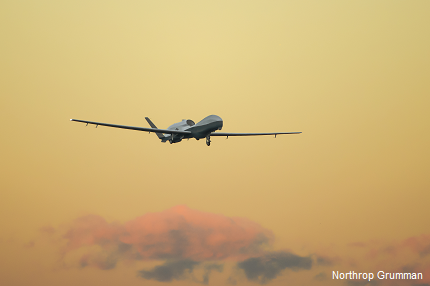Navy’s high-flying Triton drone completes initial flight tests
The unmanned aircraft will add over 2.7 million square miles of ISR coverage.

The Navy’s new MQ-4C Triton Unmanned Aircraft System, which will add vast coverage areas to maritime surveillance, recently completed its initial flight testing and before long will be accompanying the manned P-8 Poseidon maritime patrol aircraft in surveillance missions.
The recent test program, known as initial envelope expansion, validated upwards of 568 test points and was designed to measure the aircraft’s ability to fly at various altitudes, speeds, and weights, according to a Northrop Grumman announcement.
Based on the Global Hawk UAS design, the Triton will have a reinforced airframe and wings, as well as de-icing and lighting protection systems, allowing it to descend through cloud layers to get a better look at ships and other sea targets.
The UAV reached a maximum altitude of 59,950 feet and has conducted long-endurance flights totaling 81 hours, according to Navy Capt. Jim Hoke, Triton program manager with Naval Air Systems Command. The test team conducted 13 flights throughout the test period.
"Following Triton's first flight in May [2013], we've seen a steady increase in the number of test flights and test points being accomplished," Hoke said. "We're now working to fly the second test aircraft and then prepare to ferry both aircraft to Naval Air Station Patuxent River."
Once both of the test aircraft reach the station, the test team will begin installing and testing sensor suites to validate each payload.
The Triton is designed to carry several different intelligence, surveillance, and reconnaissance (ISR) payloads, providing information sharing capabilities, airborne communications, radar detection and high-resolution imagery. The Navy has said it will be integral to its surveillance strategy for the Asia and Pacific regions.
One of the sensors is the Multi-Function Active Sensor (MFAS) that was tested in 2013, reports IHS Janes. The sensor is an active electronically scanned array radar that provides a 360-degree field of view, and is able to combine electronic scanning and mechanical rotation to focus on specific geographic regions for long periods of time.
The MFAS is to be combined with the Automatic Identification System (AIS), which can identify and locate vessels.
The Triton UAS will work in conjunction with Boeing’s manned P-8 Poseidon maritime patrol aircraft. The primary mission of both systems is to conduct ISR missions across vast expanses of ocean and coastal regions. The Triton will add over 2.7 million square miles of coverage to each single ISR mission, and is capable of maintaining a view radius of over 2,000 nautical miles and flying missions lasting up to 24 hours.
The Navy had intended to acquire a total of 68 Triton UAS, but the service’s most recent budget proposal only calls for 60 aircraft, reports Flightglobal. The Navy intends to obtain 16 aircraft by fiscal year 2019 -- the other 44 will be acquired after that date.
The Navy intends to complete initial operational testing and reach operational capability for the Triton by 2017.




